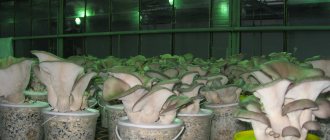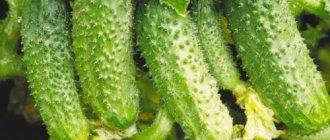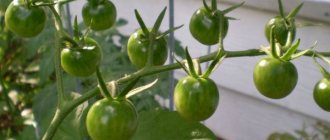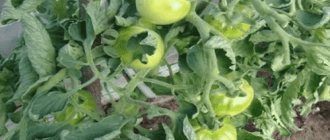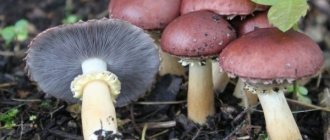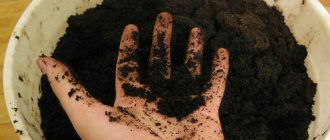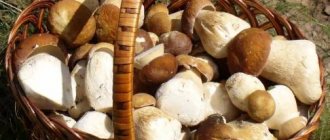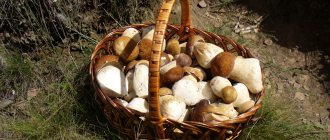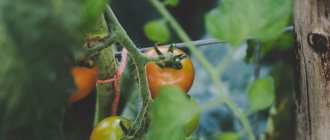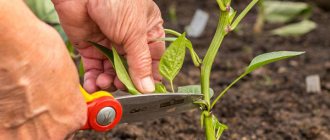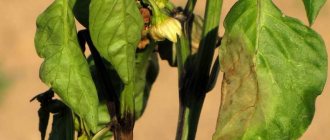Damp weather, prolonged periods of precipitation without a single sunny day with large daily temperature changes create ideal conditions for the spread of late blight and other fungal diseases. However, not only they thrive in the beds, but also their much larger and more noticeable mushrooms. Closer to autumn, here and there unexpected guests appear on the site - small and large mushrooms. They may look very attractive, but they do not cause joy, but additional anxiety. And more often than not, they are completely justified. The appearance of mushrooms in the beds is a signal of soil fertility, but even more so of negative changes in soil characteristics that should not be ignored.
Mushrooms in the beds that we are not happy about. © reffo2011
Mushrooms in beds - a one-time problem or systemic problems?
Doubts arise for any summer resident who discovers friendly mushroom caps where they should not be. The appearance of mushrooms in decorative groups with conifers, in heather gardens, near ponds, snags and stumps can be explained by the characteristics of the soil. In the garden, where in principle they should not be, such guests should become a reason not just for concern, but for careful analysis. The conditions of beds with loose, fertile, breathable soil are very different from the microclimate in which mushrooms usually thrive. And if they are comfortable in the garden, then you should definitely look for the reason for their appearance.
The answer to the question of whether the appearance of unwanted mushrooms in the garden is a problem or just an accident that can be ignored is quite simple:
- If mushrooms appeared once, in an extremely unlucky year (when the weather was not pleasant at all), but disappeared from the site the following year, then this phenomenon can be completely ignored. But you are rarely so lucky.
- If mushrooms appear year after year, and even more so, there are more and more of them in the garden, simply leaving everything as it is is dangerous indifference. After all, if mushrooms really signal negative processes in the soil that prevent its full use for growing greens and vegetables, then the sooner they are resolved, the better. Plus, mushrooms spread too easily, are a nuisance, and are especially dangerous if you have small children or curious pets.
Micro- and macroparasites
Parasitic fungi are divided into two groups:
- Microparasites. They multiply inside the host or in the cells of his body. Most often, such pathogens belong to the class of chytridiomycetes; they can be found in algae, in invertebrate animals or on the roots of terrestrial plants.
- Macroparasites grow in the host's body, but use special forms for reproduction. Over time, the parasites leave the host's body. This group includes ascomycetes, deuteromycetes, oomycetes and basidiomycetes.
Why do mushrooms appear in garden beds?
Mushroom spores, as in nature, will always exist in some quantity in the garden. Old trees, stumps, snags on your property, at your neighbors' place or off-road, manure (especially horse manure), imported black soil, sawdust and even container crops infected with mycelium spores - there can be many options. Most often, fungal spores are introduced with organic fertilizers or spread throughout the beds from mushrooms growing nearby near the border, fence, or stump. But no matter how they get into the garden, spores can germinate and develop only in favorable conditions, when the combination of dampness, fertility and acidity of the soil they need arises.
The “starting” conditions in the beds, in principle, should be so far from what the mushrooms need that such a problem should not arise. Overwatering, lack of loosening, rampant weeds, improper use of fertilizers, refusal to take measures to restore fertility and maintain air permeability, etc. are the real reasons why unwanted mushrooms appear in the beds, which need to be combated.
An old stump may be one of the reasons for the appearance of mushrooms on the site
Methods for solving the problem
Most landowners do not like the appearance of the fungal family. Very rapid reproduction in a short time can fill the entire greenhouse area, therefore, when the first “guests” are discovered, it is necessary to immediately begin destruction measures. If mushrooms have grown in a greenhouse, you can use one of the following methods:
- mechanical removal (while the number is small, each mushroom can be pulled out of the ground along with the roots, which stops their reproduction);
- digging out a layer of soil (the surface of the soil at the site of spore growth is removed);
- chemical influence, including substances that stop the growth and reproduction of fungal elements.
To remove chemically, you can use substances such as phytosporin, vinegar essence, Bordeaux mixture, salt, copper sulfate, dishwashing detergent diluted in water. These substances will stop the growth of the kingdom of living nature for some time, but will not eliminate it forever. In order to prevent such “residents” of the greenhouse from returning again, a number of actions must be performed:
- Remove old rotten boards and rotten stumps from the territory of the greenhouse and the entire site;
- Reduce soil moisture;
- Remove plants that create shade in the garden (trees, bushes) as much as possible;
- Carry out soil loosening procedures more often.
If mushrooms appear in the greenhouse, and the owner wants to get rid of them, then it is recommended to carry out all the above actions. An integrated approach will increase the percentage of work efficiency. High-quality implementation of measures will save plants from unwanted symbiosis.
“Good” and “bad” signals that mushrooms give
Mushrooms accidentally discovered in the garden are unwanted guests, but not enemies at all, but rather helpers. Mushrooms are equally valuable and irreplaceable for the ecosystem, although they can be very different - from parasitic to symbiotic. And their benefit or harm is always conditional and multifaceted. And in the garden too.
They participate in the processing of organic matter into forms accessible to plants, release enzymes into the soil and suppress diseases, increase the activity of the microbiota... And even when they interfere, suppress, “wash out”, they still signal obvious problems, indicating what exactly needs to be corrected. And such “help” is sometimes very valuable.
The appearance of mushrooms in the beds indicates only two negative phenomena that can jeopardize the full use of the beds:
- soil acidification : both in the garden and in the greenhouse, mushrooms signal that the soil reaction has begun to change towards acidic;
- soil compaction , impaired water permeability and, as a result, dampness, stagnation of moisture in the soil; in the first year, moisture retention can contribute to a better harvest of salads, cucumbers and zucchini, but in the future too dense soil will become a big problem; It is no coincidence that all the main crops traditionally grown in the garden prefer breathable, loose soil, and the appearance of mushrooms indicates that precisely its texture and ability to pass moisture and air are deteriorating.
Both problems will only get worse over time. And the sooner measures are taken, the more effective they will be.
Of course, one should not ignore the fact that the appearance of mushrooms also indicates very good phenomena - active soil microbiota and its nutritional value, good organic content. But such a “compliment” to fertility and humus content does not cancel or exceed the alarming signs of changes in soil acidity and texture.
Rules for controlling parasites
Pathogenic fungi cause quite severe damage to agriculture: tinder fungus, smut and ergot cause damage to cereals and potatoes.
Fighting them is a rather complex and lengthy process. In order to prevent infection by parasitic fungi, it is recommended to follow the rules of hygiene and ensure optimal water and air conditions.
If the fungus has settled on one of the crops, it is necessary to treat the seeds with pesticides immediately before planting. In order to prevent the penetration of mycelium into the sprouts, it is recommended to spray the shoots with formaldehyde.
As a preventive method, experts advise breeding only those plant varieties that are resistant to fungal diseases.
What mushrooms grow in the garden beds?
Mushrooms that appear in garden beds are almost automatically classified as “toadstools.” Experienced mushroom pickers, of course, have a much better understanding of the species and their characteristics. But it is still difficult to accurately recognize edible, conditionally edible and poisonous mushrooms without inviting a specialist. After all, barely discernible differences in the structure of the legs, “skirts,” and caps of many species can confuse anyone.
Pale toadstools, honey mushrooms, slime mushrooms, entomolas, May mushrooms, umbrellas, oyster mushrooms may appear in the beds... However, it is not at all necessary to find out the type of mushroom. After all, they still have to be removed from the beds.
Even if you have enough experience in the mushroom business or a specialist has accurately identified the species, it is still better to consider any unexpected mushroom to be inedible. And stop eating even those mushrooms that you recognize as your favorites. The reason is very simple: mushrooms actively absorb toxins, nitrates, and mineral fertilizers. In fact, all the means used in the vegetable garden and garden for both plant protection and fertilizing end up “inside” the mushrooms.
And if you can control your activities, then it is sometimes difficult to judge what is accidentally spread from neighboring areas. Enjoying your own and your neighbors’ “chemistry” is a dubious prospect. So, in any case, it is not worth collecting crops from spontaneous myceliums in the garden.
But you shouldn’t worry about the toxicity (danger) of mushrooms, which most often frightens you when you find caps in the beds. Even toadstools and fly agarics, no matter how many of them appear, do not pose a direct danger to all nearby cultivated plants; they do not poison or spoil the harvest. And especially not to infect them with spores.
It is not at all necessary to find out the type of mushrooms in the beds, because they will still have to be removed. © Hugh Hudson
Positive qualities of having mushroom families in the greenhouse
Representatives of the kingdom of living nature have a positive effect on vegetable crops planted in a greenhouse. Such aspects include:
- Mushroom mycelium is able to retain moisture in the soil, so the soil in the greenhouse does not dry out, vegetables always have moist soil;
- Plants cannot “digest” heavy organic compounds, but fungi can easily break them down. This action helps improve the nutrition of vegetables, since after the breakdown of organic matter, seedlings can absorb it;
- Mushroom plantings process minerals, after which plants can make up for the lack of elements;
- Reserves of humus, phosphorus, and potassium are contained in large quantities in the soil, but they are not available to cultivated plants due to the lack of enzymes for breakdown. Mushrooms perfectly process complex biochemical compounds, after which the plants can fully feed;
- If toadstools grow in a greenhouse, this can double the yield of cucumbers.
Gardeners are trying to find a way to get rid of toadstools (a poisonous mushroom from the fly agaric genus) in the greenhouse, but most of them confuse this species with the ordinary edible dung beetle. While the white dung beetle is common, the gray species is not familiar to many people. As a result, it is confused with the toadstool. These mushrooms love loose soil fertilized with manure (hence the name). Toadstool, in turn, is very rare in garden plots. Therefore, when mushroom clearings are discovered, you should identify the species using a reference book, or check with a specialist about its genus.
Note! Quite often, mushrooms begin to grow after fertilizing the soil with manure. The spores contained in it quickly create a clearing of an “unexpected harvest.”
The artificial application of fungal spores with fertilizer is the main reason for the appearance of the crop in greenhouse conditions. Mycelium can also come from imported soil, collected in the forest, purchased from rural estates, or purchased by order on the Internet. After applying horse manure, mushrooms can often be seen. Among the negative aspects, some gardeners notice that vegetable crops do not tolerate proximity to mushroom glades. In this case, it is necessary to eliminate mushrooms from the beds in order to prevent the loss of not only the crop, but the plant itself.
How to fight mold on and under mulch
Temporary decreases and increases in temperature, humidity, acidity, etc. mold is not scary. The only thing it does not tolerate is high-temperature treatment for a long time.
First, assess the scale of the problem. If the weather is dry, the plants in the mulched area look good, and there are only a few small pockets of mold that do not dry out in the sun, perhaps you should simply remove the “spoiled” mulch, and then spray the beds with a weak solution of Fitosporin-M to prevent its further appearance.
If the mulch is wet and moldy in a tight bag during storage (but there is no mucus, rotting elements, or strong unpleasant odor), pour it in an even layer on the surface and dry completely in the sun and fresh air, and only then lay it under the plants, again, spilling a weak fungicide solution. Excess dried mulch can be sent for further storage, preventing it from getting wet again in the future.
If the soil under a layer of mulch is heavily covered with mold, the mulch is constantly wet, smells bad and the plants look depressed, get rid of the old mulch, dry the soil naturally and, after loosening the soil, add new dry mulch suitable for a specific crop.
If mold regularly appears in the greenhouse, it may have already “gone” from the mulch and moved onto the wooden greenhouse structures. In this case, it is extremely important not only to get rid of the rotting mulch material, but also to disinfect the greenhouse itself.
Which greenhouse is suitable for growing mushrooms?
So, each variety has its own greenhouse. For example, even cellars with basements are suitable for oyster mushrooms, which have become very popular recently, if they have a certain temperature and humidity. But the most delicious mushrooms - champignons - can be grown in the most ordinary film greenhouse.
In general, mushrooms are a tricky material to grow, but in moderation. Much in this regard still depends on the variety. But in any case, lighting, temperature conditions, fertilizers and humidity levels must be correct.
Why does it occur
A favorable environment for the intensive development of late blight is long-term moisture. The disease most often manifests itself at temperatures below +24-25 °C and the onset of rainy weather.
Signs of late blight are observed more often in the third decade of July, but during the cool summer season, a dangerous infection can appear on tomatoes earlier. Therefore, it is important to inspect your plants regularly.
The main reasons for the development of Phytophthora:
- dense planting of tomatoes, leading to increased humidity in the rows;
- heavy dew, thick fog, prolonged frequent rains;
- sharp daily temperature fluctuations;
- location of tomato ridges in low-lying, frequently flooded areas;
- poor ventilation of the greenhouse, greenhouse, which leads to the accumulation of condensation and increased humidity.
Fungal spores persist in plant waste, on garden tools, seed and planting material. When wet weather sets in, they become active.
Potato plantings located next to tomatoes pose a danger. If these plants are infected with late blight, then the spores are easily transferred on shoes, with tools, and gusts of wind. The proximity of eggplants, peppers, and petunias is also undesirable.
Places where molds spread
Molds can live and reproduce in water or soil. Their extensive colonies are distributed everywhere in warm, humid places with sufficient nutrient medium. Such an environment for mold fungi is greenhouse soil. The quality of the substrate determines the health of the plants, which depends on the quality of the grown seedlings. Changes in the quality parameters of the greenhouse soil negatively affect the growth and development of seedlings. The primary manifestation of damage to seedlings by greenhouse fungi begins with the appearance of a whitish coating on the greenhouse soil, which is the mycelium of harmful fungi.
Growing methods
To grow this amazing delicacy yourself, 2 growing techniques are used: extensive and intensive.
With the extensive method, breeding occurs in natural conditions, and the mycelium is cared for at its permanent place of growth.
For growing at home or for business development, the second method, intensive, is more suitable. To grow mushrooms in a greenhouse in this way, you will need to equip it with special equipment to create the necessary conditions and microclimate.
Conditions for development
Microscopic spores are easily transported by air currents and can remain dormant for several decades. When suitable conditions arise, they begin to grow and reproduce rapidly. In this case, living plants with soft tissues (cucumbers, tomatoes, vegetable seedlings and others like them) are captured.
Conditions most suitable for mold to grow:
- Insufficient illumination (a small amount of ultraviolet rays that enter dense plantings, as well as cloudy weather without additional lighting);
- Increased soil moisture and stagnation of water after watering at the root system. This may be due to water leakage in damaged areas of the hose or due to improper watering;
- Poor or no ventilation;
- The temperature in the greenhouse is 20–22 degrees above zero;
- Indoors humidity is 95%.
